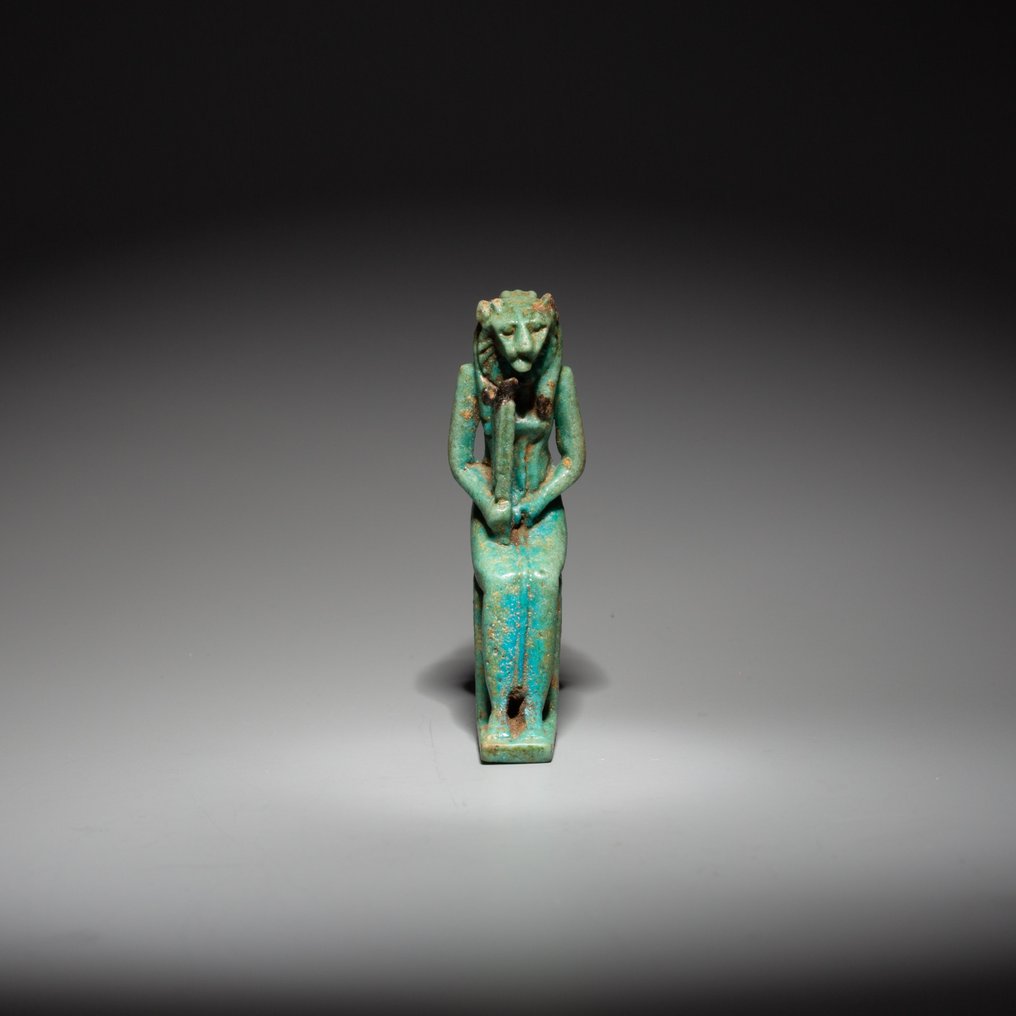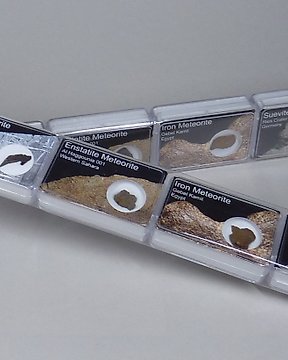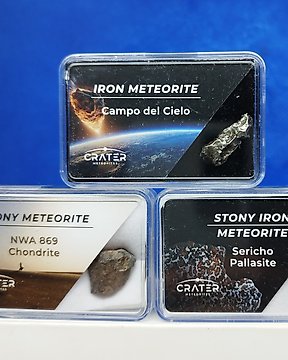Tutto bene
Ver traducciónAntiguo Egipto Fayenza Amuleto de la diosa Sekhmet. Período Tardío, 664 - 323 a.C. Muy buen ejemplo de detalles. 5 cm de
N.º 88783263



Amulet of the goddess Sekhmet.
- very nice-
Ancient Egypt, Late Period, 664 - 323 BC
MATERIAL: Faience
DIMENSIONS: 5 cm height.
PROVENANCE: Private collection, Dunfermline, UK. 1960 - 1970.
CONDITION: Good general condition, feet restored, and tear line restored at the waist.
DESCRIPTION:
An image of the Egyptian feline goddess Sekhmet. As is common in Egyptian art, the goddess is seen with the body of a human and the head of an animal. The body is that of a young slender woman wearing a long tunic clinging to her figure. Only the arms and the feet are uncovered. The head is that of a lion. On the back of the throne we find a colum of inscription. Sekhmet is holding a eye of Horus amulet.
The pointy muzzle of the feline takes the place of a human face. The substitution of the mane by a human wig seems almost natural. The working of Sekhmet’s throne was done using a technique widely used at the end of the New Kingdom for faience work which is called “openwork”. Once the figure has been modelled, the necessary empty spaces are hollowed out with a sharpened knife. Despite the fragility and delicate nature of the piece, this amulet is an excellent state of preservation. The surface has kept part of its original intense turquoise colour. Even given the small size of the piece, the quality of the craftsmanship is excellent: the anatomical details, the eyes, eyebrows, nose and mouth have been rendered with precision.
Representations of the goddess Sekhmet were very popular during the Third Intermediate Period, when the Egyptian religion evolved into regional religions and into the cult in the home of certain gods protecting the home and the individual. This religious innovation led to a great increase in the production of figurines and amulets of divine protectors such as Bastet, Bes, Patek, Tauret, Nehebkau, etc.
According to some studies the form of the ears would indicate if the statuette is a representation of Bes (who has cat-like pointy ears) or Sekhmet (who has rounded ears like a lion). As this is simply a theory, such pieces can be identified as either of the deities or both combined in one.
Sekhmet, Sejmet or Sachmis, was given titles such as “the (one who is) powerful” and “Mistress of Dread”. She was a symbol of power and force. She was a protector goddess of the pharaohs, and led them in warfare. She was considered a goddess of war and of vengeance, but at the same time goddess of healing. This dual identity is associated with the cat goddess Bastet, and this would be the image of Sekhmet when she was calm and at rest. Bastet is the gentle goddess, the lady protector against illnesses, patron of the priests, protector of women in labour and of children. Sekhmet is also represented with the solar disk headdress like the goddess Hathor, due to her being recognised as the daughter of the sun god Ra and his sun cult.
Sekhmet was worshipped as the “Lady of Asheru” in the temple of Mut in Karnak. She was also worshipped in Luxor, Memphis, Letopolis and the Delta region. In some temples animals were sacrificed and their blood was offered to keep cholera away. The priests performed a ritual before a different statue of the goddess every day of the year to placate her wrath. This is the reason why so many images of the goddess are still preserved. Most of the statues do not exhibit any expression or dynamism, but rather the typical hieratic attitude of Egyptian art. It is estimated that more than 700 statues of Sekhmet stood in the Temple of Amenhotep III in Luxor and in the Karnak Temple. The majority of the effigies found were sculpted during the reign of this pharaoh. Tame lions were kept in temples dedicated to Sekhmet in Leonopolis.
The material used for the creation of this amulet is faience, composed of fine sand cemented with sodium carbonate and sodium bicarbonate extracted from natron. Fired at 950 ºC, the mixture gives an enamel-like finish with the carbonates forming a vitreous surface. It was a simple procedure and therefore not costly. The green and blue tones were achieved by the addition of a few grams of copper oxide extracted from malachite or azurite. The red tones were achieved with iron oxide, the intense blues with cobalt, the black by mixing iron oxide and magnesium oxide with water. All that was needed was to paint the chosen details in the selected colour with a brush before the firing.
Notes:
The seller guarantees that he acquired this piece according to all national and international laws related to the ownership of cultural property. Provenance statement seen by Catawiki.
The seller will take care that any necessary permits, like an export license will be arranged, he will inform the buyer about the status of it if this takes more than a few days.
The piece includes authenticity certificate.
The piece includes Spanish Export License.
El vendedor y su historia
Amulet of the goddess Sekhmet.
- very nice-
Ancient Egypt, Late Period, 664 - 323 BC
MATERIAL: Faience
DIMENSIONS: 5 cm height.
PROVENANCE: Private collection, Dunfermline, UK. 1960 - 1970.
CONDITION: Good general condition, feet restored, and tear line restored at the waist.
DESCRIPTION:
An image of the Egyptian feline goddess Sekhmet. As is common in Egyptian art, the goddess is seen with the body of a human and the head of an animal. The body is that of a young slender woman wearing a long tunic clinging to her figure. Only the arms and the feet are uncovered. The head is that of a lion. On the back of the throne we find a colum of inscription. Sekhmet is holding a eye of Horus amulet.
The pointy muzzle of the feline takes the place of a human face. The substitution of the mane by a human wig seems almost natural. The working of Sekhmet’s throne was done using a technique widely used at the end of the New Kingdom for faience work which is called “openwork”. Once the figure has been modelled, the necessary empty spaces are hollowed out with a sharpened knife. Despite the fragility and delicate nature of the piece, this amulet is an excellent state of preservation. The surface has kept part of its original intense turquoise colour. Even given the small size of the piece, the quality of the craftsmanship is excellent: the anatomical details, the eyes, eyebrows, nose and mouth have been rendered with precision.
Representations of the goddess Sekhmet were very popular during the Third Intermediate Period, when the Egyptian religion evolved into regional religions and into the cult in the home of certain gods protecting the home and the individual. This religious innovation led to a great increase in the production of figurines and amulets of divine protectors such as Bastet, Bes, Patek, Tauret, Nehebkau, etc.
According to some studies the form of the ears would indicate if the statuette is a representation of Bes (who has cat-like pointy ears) or Sekhmet (who has rounded ears like a lion). As this is simply a theory, such pieces can be identified as either of the deities or both combined in one.
Sekhmet, Sejmet or Sachmis, was given titles such as “the (one who is) powerful” and “Mistress of Dread”. She was a symbol of power and force. She was a protector goddess of the pharaohs, and led them in warfare. She was considered a goddess of war and of vengeance, but at the same time goddess of healing. This dual identity is associated with the cat goddess Bastet, and this would be the image of Sekhmet when she was calm and at rest. Bastet is the gentle goddess, the lady protector against illnesses, patron of the priests, protector of women in labour and of children. Sekhmet is also represented with the solar disk headdress like the goddess Hathor, due to her being recognised as the daughter of the sun god Ra and his sun cult.
Sekhmet was worshipped as the “Lady of Asheru” in the temple of Mut in Karnak. She was also worshipped in Luxor, Memphis, Letopolis and the Delta region. In some temples animals were sacrificed and their blood was offered to keep cholera away. The priests performed a ritual before a different statue of the goddess every day of the year to placate her wrath. This is the reason why so many images of the goddess are still preserved. Most of the statues do not exhibit any expression or dynamism, but rather the typical hieratic attitude of Egyptian art. It is estimated that more than 700 statues of Sekhmet stood in the Temple of Amenhotep III in Luxor and in the Karnak Temple. The majority of the effigies found were sculpted during the reign of this pharaoh. Tame lions were kept in temples dedicated to Sekhmet in Leonopolis.
The material used for the creation of this amulet is faience, composed of fine sand cemented with sodium carbonate and sodium bicarbonate extracted from natron. Fired at 950 ºC, the mixture gives an enamel-like finish with the carbonates forming a vitreous surface. It was a simple procedure and therefore not costly. The green and blue tones were achieved by the addition of a few grams of copper oxide extracted from malachite or azurite. The red tones were achieved with iron oxide, the intense blues with cobalt, the black by mixing iron oxide and magnesium oxide with water. All that was needed was to paint the chosen details in the selected colour with a brush before the firing.
Notes:
The seller guarantees that he acquired this piece according to all national and international laws related to the ownership of cultural property. Provenance statement seen by Catawiki.
The seller will take care that any necessary permits, like an export license will be arranged, he will inform the buyer about the status of it if this takes more than a few days.
The piece includes authenticity certificate.
The piece includes Spanish Export License.
El vendedor y su historia
- 831
- 9
- 1
It's always a pleasure. Until next time. Thank you.
Ver traducciónHappy with the purchase, the order arrived intact. Item is in good condition, and advertised, everything went great
Ver traducciónEverything was perfect! thank you regards
Ver traducciónExcelente vendedor. Todo muy bien. El envío muy rápido. Recomendable. Muchas gracias
Ver traducciónvery good as always
Ver traducciónTrès beaux objets de qualité avec certificats d'authenticité et explications.vendeur au Top. Merci
Ver traducciónbellissimoooooo grazie top 💯💯💯 come sempre
Ver traducciónGreat purchase! Very well packaged; arrived very fast with all the necessary paperwork. Thank you!
Ver traducciónTodo bien y rápido. Embalaje perfecto.
Ver traducciónVendeur réactif. Délai de livraison respecté . Merci! Monique
Ver traducciónTutto perfetto.
Ver traducciónThis is the second time I order with this seller and I am very positive. The terracotta item comes in a small box packed in bubble wrap. delivery is a bit expensive but safe and extremely fast.
Ver traducciónUna garantía total comprar en una tienda de objetos arqueológicos de prestigio en pleno centro de Barcelona, con toda la documentación perfectamente editada y con un trato personal muy bueno.
Ver traducciónVery swift handling and exactly as advertised
Ver traducciónVery nice statue in good conditions
Ver traducciónoggetto bellissimo corrispondente alla descrizione. Ottima confezione e dettaglio della certificazione
Ver traducciónMagnífica la entrega y el objeto. Perfecta la sonido del sibato
Ver traducciónvery well packed with all the documents included, thnks
Ver traducciónGreat object. Really beautiful. Quick delivery. Excellent.
Ver traducciónSuperbe objet, Service d'Arqueologia Ancient Art excellent et rapide. Jaume Bagot toujours parfait .
Ver traducciónTodo perfecto gracias
Ver traducciónNice item all ok A+++
Ver traducciónThank you for this Oinochoe, one question: did you as promised read my post!
Ver traducciónVery cooperative in every aspect of the transaction.
Ver traducción








